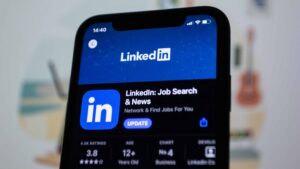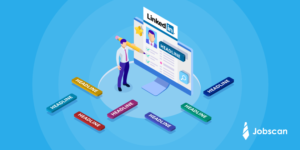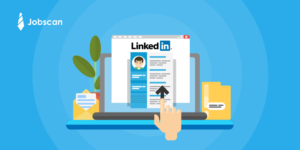There’s an old saying that goes something like, “A great website that is not promoted is like a billboard stored in your basement.” This sentiment reminds me of LinkedIn members who have strong profiles but are invisible. For those figuring out how to use LinkedIn to find a job, they must consider what a successful LinkedIn campaign consists of.
A successful LinkedIn campaign consists not only of a strong profile, it also includes building a targeted network and engaging with your connections. Anything less will not garner the results you desire, and will not help in your job search. Let’s look in greater detail at these three components.
Create a Strong LinkedIn Profile
It goes without saying that a strong profile is essential to your LinkedIn campaign. It is, after all, what expresses the value you will deliver to employers. There are a few basic tenets to follow when constructing a profile:
- It must be complete. This means having a background image, headshot photo, headline, summary, detailed experience section, education, your strongest skills, and other sections LinkedIn allows.
- It must show employers the value you’ll bring to them through accomplishments relevant to your industry and occupation, similar to your resume.
- It’s not your resume. This is a mistake many job seekers make. They simply copy and paste their resume to their profile and leave it at that.
- It must be optimized to attract visitors, such as recruiters, through LinkedIn Search.
- It must show your personality. Look at your profile as an online networking document. Write your profile in first-person point of view; perhaps 3rd person only if you feel it fits your personality.
Try Jobscan’s LinkedIn Optimization tool for personalized tips for your profile.

Build a Targeted LinkedIn Network
I recall a client of mine who had a strong profile but was only connected to 80 people. When I told her she needed to connect with more people, she told me she only wanted to connect with people she knows.
Herein lies the problem: people need to connect with others they don’t know in order to get to know them. If you are someone who doesn’t embrace the concept of connecting with targeted people, your LinkedIn campaign will be a bust.
Who do you connect with on LinkedIn? Let’s look at some of the people with whom you should connect by tier:
Connect with Former Colleagues
Your first tier will consist of those you previously worked with, as they know your performance and probably will have an invested interest in your success. Many job seekers rely on their former colleagues as referrals to land their next job.
Connect with Industry Peers
Your second tier of connections should be people who share the same occupation and industry. You’ll have more in common with them than the other tiers. Let’s say you’re an accountant in the manufacturing industry. It makes common sense to connect with others like you. They may know of opportunities and provide great leads, especially if they’re currently working.
Connect with Decision Makers and Influencers at Target Companies
Your third tier can be perhaps the most valuable one– if you’re willing to do your research on companies for which you’d like to work. You will connect with people within those companies before jobs are advertised. This will give you allies in those companies.
Engaging with Your Connections on LinkedIn
We’re all familiar with the saying, “Out of sight, out of mind.” When it comes to engaging with your connections, your goal is to keep your network thriving in order to be top of mind.
This takes some work that many LinkedIn users are unwilling to do. I ask my clients to dedicate at least 20 minutes a day, four days a week to LinkedIn. If they’re good, every day is what I suggest. (Eye rolls.) But I’m quick to say it’s not difficult. For example, one can share:
- an article that adds value to your network
- an update offering advice or asking a question that elicits great responses
- a photo with a witty caption
- a shout-out to your connections
Mark Anthony Dyson, career consultant and creator of the popular job search podcast The Voice of Job Seekers, sees engagement as something that can’t be taken lightly. “As we consider how important engagement is,” he says, “I think the tone of a user’s messaging (including responses to group posts) matters. People want to be valued and feel safe. Share and offer advice, opinion, or message without making anyone feel undervalued.”
One final point I’d like to make: refrain from sharing “Facebook content” with your connections. Most them won’t appreciate it.
Go Beyond LinkedIn
Having a great profile, connecting on LinkedIn, and engaging with your network is not enough. While you can reach out to many people online, your connections won’t be bona fide until you reach out and touch them in a personal way—perhaps make a phone call, Skype with them, or meet them in person.
Donna Serdula, an authority on LinkedIn profiles and author of LinkedIn Profile Optimization for Dummies, sums up your LinkedIn campaign nicely: “It’s true that success on LinkedIn hinges upon an optimized, strategic profile, but that’s not all! In order to be found on LinkedIn, you need a strong, robust network. In order to be seen, you need to have an engaging feed of posts, comments, shares, and articles. In order to be sought after, you need to add value, inspire others, and have fun.”
LinkedIn Job Search FAQ
What should I say on LinkedIn when looking for a job?
To indicate that you are job seeking, you can add a few words to your LinkedIn headline along the lines of “experienced X professional currently seeking new opportunities.”
How do you get recruiters to notice you on LinkedIn?
To get recruiters’ attention, be proactive! Don’t just wait for them to reach out to you. Instead, do your research and connect with them. Send a connection request and make sure to add a personalized note. For example, compliment them on an article they wrote or even ask them a question about the company they represent. The important thing is to start a conversation with them and make sure you are memorable.
How should a beginner use LinkedIn?
After setting up their LinkedIn accounts with the advice shared above, beginners should focus on networking and sending connection requests. Again, be proactive! You want to get your name out there, make genuine connections with those in your industry, and participate in conversations happening in your feed.
Additional Resources: How to Use LinkedIn to Find a Job
- Optimize your profile with LinkedIn Optimization
- 10 Impactful LinkedIn Headline Examples from Real People
- How to Write a LinkedIn Summary
- 24 LinkedIn Profile Tips to Make You Stand Out in 2023

Bob McIntosh, CPRW, is a career trainer who leads more than 15 job search workshops at an urban career center. Job seekers and staff look to him for advice on the job search. In addition, Bob has gained a reputation as a LinkedIn authority in the community. He has reviewed and written hundreds of LinkedIn profiles. Bob’s greatest pleasure is helping people find rewarding careers in a competitive job market.
















